
Birds of fjelds (= mountains in Lapland)
You will find some birds of fjelds there, too:
The clear limit for birds in nature is the northern limit of conifers. The limit for birch is in the latitude of about 600-800 meters (the same limit for the conifers is 400-500 metres). In the limits of fell birch stands (Betula tortuosa) and treeless area are junipers, dwarf birches and willow bushes common (see forestzones in Lapland!).
About 20 bird species are living in the top of fjelds, e.g. snow bunting, ptarmigan, European golden plover, keräkurmitsa, lapinsirkku and bluethroat.
See also the sections "Some northern bird species" and "Migration of birds" (menu above)!
The mountain birch areas are usually quite wide because the hillsides are gentle. The most common birds there are willow warbler, fieldfare, bramling and redpoll. Two first ones are common everywhere in Finland, two last ones are northern birds. As a matter of fact, redpoll wanders in wide areas especially during winter.
Bluethroat favours willow bushes near brooks. Lapland’s nightingale redwing sings mostly during nights. The phrase of its song is shorter and simpler than the one southern redwing has. Also ring ouzel likes to live in the fell area of Lapland.
You can meet willow grouse in Southern Finland, too, but its own territory is fell birch stands in Lapland. Willow grouse is not a migrating bird. It has very good protection colours both in winter and in summer. It’s able to tolerate the harsh winter, when it is extremely cold it digs a hole ‘kieppi’ under snow and sleeps there.
In the bushes and near brooks in the lower limits of treeless area you can still meet little flocks of redpolls, bluethroats and meadow pipits. Wheater nests in rocky soils of fells.
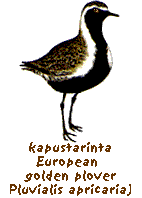 In the fell heaths of treeless area lives for example golden plover. This bird has very beautiful but excellent protect colour. Like many other shorebirds also the golden plover plays wing-broken if an animal (or a man) threats its fledglings. Dotterel is more rare, but lives in the same landscape.
In the fell heaths of treeless area lives for example golden plover. This bird has very beautiful but excellent protect colour. Like many other shorebirds also the golden plover plays wing-broken if an animal (or a man) threats its fledglings. Dotterel is more rare, but lives in the same landscape.
Long-tailed skua lives in the treeless areas especially when the lemmings and moles are abundant. The same is with big snowy owl which is white through the year. These days it’s quite rare but when it’s poor mole year it can wander souther. Snowy owl too can play wounded if something threats its fledglings. Also the frequency of rough-legged skua is dependent on the amount of lemmings and moles
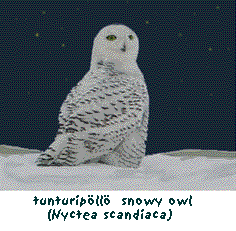
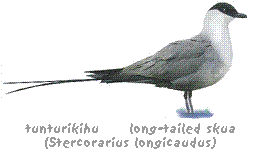
In the uppermost parts of fells, in the rock soil where there is very little vegetation left you can meet for example snow bunting and ptarmigan.
In the mires (= peatlands) of Lapland lives many typical bird species. Wood sandpiper - shorebird, too - is one of the most characteristic ones. Also whimbrel, ruff, greenshank, spotted redshank and some sandpipers (among others broad-billed sandpipedr) are typical mire birds of Lapland, as well as meadow pipit, yellow wagtail, reed bunting (willow grouse), lapland bunting, grane, whooper (swan) and bean goose.
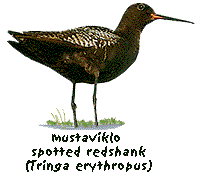
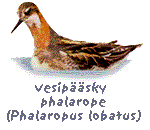
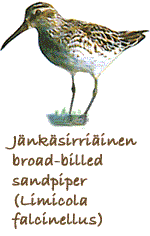
Red-necked phalarope is quite fearless bird that lives in sedge-surrounded ponds in Lapland. The male takes alone care of fledglings after female has laid eggs.
In the brooks of Lapland you can also meet for example dipper. Typical Anseriformes in Lapland but also in the whole country are for example teal, pintail, wigeon, red-throated diver, black-throated diver and red-breasted merganser. Then there are few almost arctic aquatic birds like lesser white-fronted goose and long-tailed duck..
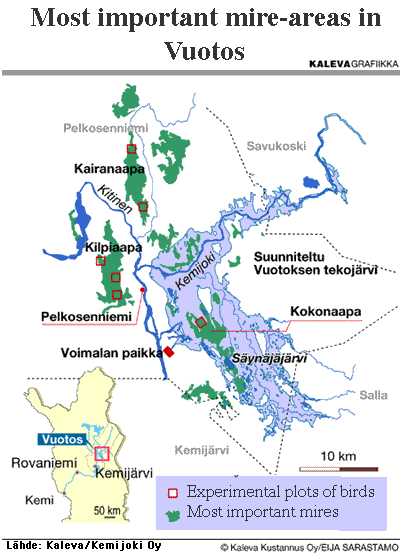
Vuotoksen suunnitellun tekoallasalueen länsipuolella sijaitsevat aapasuot Kairanaapa ja Kilpiaapa edustavat erinomaisesti paitsi pohjoisia aapasoita myös Lapin suolinnustoa. Esim. vesipääsky ja jänkäsirri ovat siellä varsin yleisiä. Koko maapallon jänkäsirriäisistä yli kaksi kolmasosaa pesii Suomessa. Suunniteltua allasta ei voimassaolevien päätösten mukaisesti toteuteta, joten suot säilyvät koskemattomina!
The section "Birds oof fjelds" ends here!
If you like some other birds, click here!
If you like some other animals, click here!
Other sections: Main menu on the upper part of this screen!